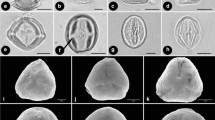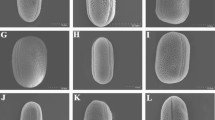Abstract
To better understand the taxonomy and phylogeny of the Dicomeae (Asteraceae) the pollen morphology of seven genera including 15 species of that tribe and six genera with seven species belonging to five related tribes was studied by use of light and scanning electron microscopy. The quantitative data were analysed by use of principal-components analysis (PCA). The exine ultrastructure of Erythrocephalum longifolium and Pleiotaxis rugosa was also studied by use of transmission electron microscopy. Three pollen types were distinguishable from the apertural, columellar, and spinular morphology and inter-spinular sculpture. A dichotomous key to these pollen types is proposed. The existence of the Dicomeae as an independent tribe and its subdivision in two subtribes (Dicominae and Pleiotaxinae) are supported by this study, which also suggests the Oldenburgieae and the Tarchonantheae are the closest tribes to Dicomeae.






Similar content being viewed by others
References
Blackmore S, Wortley AH, Skvarla JJ, Robinson H (2009) Evolution of pollen in compositae. In: Funk VA, Susanna A, Stuessy TF, Bayer RJ (eds) Systematics, evolution, and biogeography of compositae. Sheridan Books Inc, Ann Arbor, Michigan, pp 101–130
Blackmore S, Wortley AH, Skvarla JJ, Gabarayeva AH, Rowley JR (2010) Developmental origins of structural diversity in pollen walls of compositae. Plant Syst Evol 284:17–32
Bolick M (1978) Taxonomic, evolutionary and functional considerations of compositae pollen ultrastructure and sculpture. Plant Syst Evol 130:209–218
Bolick M (1991) Pollen diameter, exine thickness, and ultrastructure type in the tribes of the compositae. Comp News 19:17–21
Bremer K (1994) Asteraceae. Cladistics and classification. Timber Press, Portland
Cabrera AL (1977) Mutisieae—systematic review. In: Heywood VH, Harborne JB, Turner BL (eds) The biology and chemistry of the compositae, vol 2. Academic Press, London, pp 1039–1066
Erdtman G (1960) The acetolysis method. Svensk Bot Tidskr 54:561–564
Funk V, Susanna A, Stuessy TF, Bayer RJ (2009) Systematics, evolution and biogeography of compositae. Sheridan Books Inc, Ann Arbor
Hansen HV (1990) SEM-studies and general comments on pollen in tribe Mutisieae (compositae) sensu Cabrera. Nord J Bot 10:607–623
Hesse M, Halbritter H, Zetter R, Weber M, Buchner R, Frosh-Radivo A, Ulrich S (2009) Pollen terminology—an illustrated handbook. Springer, Wien, New York
Hoffmann O (1890) Compositae. In: Engler A, Prantl K (eds) Die Natürlichen Pflanzenfamilien, vol 4., 5Engelmann, Leipzig, pp 87–391
Jeffrey C (1967) Notes on compositae, II. The Mutisieae in East Tropical Africa. Kew Bull 21:177–223
Legendre P, Legendre L (1998) Numerical ecology 2nd English edition. Elsevier Science BV, Amsterdam
Muller J (1979) Form and function in Angiosperm pollen. Ann Missouri Bot Gard 66:593–632
Ortiz S (2000) A phylogenetic analysis of Dicoma Cass. and related genera (Asteraceae: Cichorioideae: Mutisieae) based on morphological and anatomic characters. Ann Missouri Bot Gard 87:459–481
Ortiz S, Pereira Coutinho A (2001) Achyrothalamus reduced to Erythrocephalum (Asteraceae, Mutisieae). Taxon 50:389–403
Ortiz S, Carbajal R, Serrano M, Coutinho AP (2009) Dicomeae (Carduoideae). In: Funk VA, Susanna A, Stuessy TF, Bayer RJ (eds) Systematics, evolution, and biogeography of compositae. Sheridan Books Inc, Ann Arbor, Michigan, pp 267–278
Panero JL, Funk VA (2002) Toward a phylogenetic sub familial classification for the compositae (Asteraceae). Proc Biol Soc Wash 115:909–922
Panero JL, Funk VA (2008) The value of sampling anomalous genera in phylogenetic studies: major clades of the Asteraceae revealed. Mol Phylogenet Evol 47:757–782
Parra O, Marticorena C (1972) Granos de polen de plantas chilenas. II. Compositae—Mutisieae. Gayana 21:3–107
Pereira Coutinho A, Dinis AM (2007) A contribution to the ultrastructural knowledge of the pollen exine in subtribe Inulinae (Inuleae, Asteraceae). Plant Syst Evol 269:159–170
Perveen A (1999) Contributions to the Pollen morphology of the family compositae. Tr J of Biology 23:523–535
Punt W, Hoen PP, Blackmore S, Nilsson S, Le Thomas A (2007) Glossary of pollen and spore terminology. Rev Palaeobot Palynol 143:1–81
Skvarla JJ, Larson D (1965) An electron microscopic study of pollen morphology in compositae with special reference to the Ambrosiinae. Grana Palynol 6(2):210–267
Skvarla JJ, Turner BL, Patel VC, Tomb AS (1977) Pollen morphology in the compositae and in morphologically related families. In: Heywood VH, Harborne JB, Turner BL (eds) The biology and chemistry of compositae. Academic, London, pp 141–265
Skvarla JJ, DeVore ML, Chissoe WF (2005) Lophate sculpture of Vernonieae (compositae) pollen. Rev Palaeobot Palynol 133:51–68
Stix E (1960) Pollenmorphologische Untersuchungen an Compositen. Grana Palynol 2(2):41–114
Tellería MC (2008) Taxonomic significance of pollen types in the Guayana highland-centred composite genera of Mutisioideae (Asteraceae). Bot J Linn Soc 156:327–340
Tellería MC, Katinas L (2005) The unusual occurrence of tricolpate pollen within Mutisieae (Asteraceae). Grana 44:91–97
Ubiergo P, Lapp M, Torrecilla P (2009) Morfología del polen de especies de Gongylolepis (Mutisieae: Asteraceae) de la Guayana venezolana. Anales Jard Bot Madrid 66(1):93–107
Urtubey E, Tellería MC (1998) Pollen morphology of the subfamily Barnadesioideae (Asteraceae) and its phylogenetic and taxonomic significance. Rev Palaeobot Palynol 104:19–37
Wodehouse RP (1929) Pollen grains in the identification and classification of plants. IV. The Mutisieae. Am J Bot 16:297–313
Wortley AH, Funk VA, Skvarla JJ (2008) Pollen and the evolution of Arctotideae (compositae). Bot Rev 74:438–466
Zavada M, De Villiers S (2000) Pollen of the Asteraceae from the Paleocene–Eocene of South Africa. Grana 39:39–45
Acknowledgments
The authors are grateful to the Directors of the COI, K, MA, NBG, PRE, and S herbaria for the loan of herbarium vouchers. The authors also thank Professor Augusto Dinis for allowing the use of equipment from the Laboratory of Microscopy, Department of Life Sciences (University of Coimbra), Professor Carlos Gonçalves, Director of the Laboratory of Histology of the Faculty of Medicine of the same University, for kindly helping us to obtain SEM micrographs of Pleiotaxis, and the anonymous reviewer.
Author information
Authors and Affiliations
Corresponding author
Appendix: Studied specimens
Appendix: Studied specimens
Brachylaena discolor DC.
Moçambique. Ilha de Inhaca, 3.IX.1975, A. Reis Moura 695 (COI). Ilha de Inhaca, 27.VII1982, D. Zuzunga 357 (COI).
Chuquiraga jussieui J. F. Gmel.
Bolivia. LaPaz, Murillo, entre LaPaz y Palca, 25. II. 1979, A. Ceballos, Charpin, F. Casas & V. Bermejo BO-522 (MA).
Chuquiraga oppositifolia D. Don
Chile. Prov. Colchaqua, San Fernando, Termas del Flaco, 13. XI. 1983, G. Montero 12450 (MA).
Cloiselia carbonaria S. Moore
Madagascar. Vallées du Mangoky et de L’ Isahaina, 10/1933, 11294 (K). La Table, Tuléar, 11. XI. 1962, F. Chauvet 359 (K). Plateau calcaire Mahafaly entre Stample et Ampanily, 16. X. 1970, M. Keraudren-Aymonin & G. Aymonin 24572 (K).
Cloiselia oleifolia (Humbert) S. Ortiz
Madagascar. Collines des environs de Berlanyer, V. 1902, H. Bâthie 1428 (K). Environs de Tuléar, 6. XI. 1960, J. Leandri, Ratoto, Jean de Dieu 3730 (K).
Dicoma anomala Sond.
Zaire. Haut-Shaba, Plateau de la Monica. Angola. Huíla, Humpata, 9. VI. 1960, Teixeira & Andrade 4740 (COI). Huambo, Nova Lisboa, Chianga, 6. VII. 1970, Silva 3181 (COI).
Dicoma tomentosa Cass.
Angola. Mossâmedes, 26. IV. 1938, Abreu 81 (COI). Mozambique. Tete, pr. Missão de Boroma, 21. VI. 1941, A. R. Torre 2921 (COI).
“Dicomopsis” welwitschii (= Dicoma welwitschii O. Hoffm.)
Angola. Benguela, Cacomba, 26. VII. 1905, Gossweiler 1798 (COI). Iter. Angolense, s. d., Welwitsch 3629 (COI). Quanza Sul, 24. VI. 1942, Excell & Mendonça 3069 (COI). Huambo, Nova Lisboa, 15. VI, 1971, M. da Silva 3668 (COI).
Erythrocephalum longifolium Benth. ex Oliv.
Kenia. 8. I. 1969, Mouarig 114 (K). N’Gomeni, Tanga, 18. IV. 1964, H. Faackman, 3980 (K). Malawi. Musidi Road, 8. I. 1969, Mouarig 114 (K).
Erythrocephalum marginatum (O. Hoffm.) S. Ortiz & A. P. Cout.
Tanzania. Dakara Ranch, 26. IV. 1988, Pócs 86 (K).
Erythrocephalum microcephalum Dandy
Kenya. 35 miles SW of Kinui, 30. I. 1957, Bogdon 63 (K). Tanganyica. Kikori, 20. II. 1930, Burtt 64 (K). Uganda. I. 1922, Dummer 5015 (K).
Gongylolepis sp.
Venezuela. Territorio Federal del Amazonas, Depto. Atabapo, Cerro Duida, Rio Negro, 19. XI. 1991, J. Fuertes & J. M. Cardiel 1267 (MA 524239)
Macledium latifolium (DC.) S. Ortiz
South Africa. Potberg, Bredasdorp, s. d., Acocks 23014 (PRE).
Macledium sessiliflorum (Harv.) S. Ortiz
Tanzania. Kilosa District, near Ruaha River, 12 km W. of Kidatu Bridge, 4. IX. 1970, M. Thulin & B. Mhoro 856 (K). 26 km SE of Mtware, 6 km SW of Msimbati, 1. XI. 1977, R. Wingfield 4416 (K). Magubie, Mamboya, VIII. 1930, A. Haarer 1835 (K).
Macledium spinosum (L.) S. Ortiz
South Africa. Noukloof Nature Reserve, 13. XI. 1982, D. F. Laidler 432 (PRE).
Oldenburgia paradoxa Less.
South Africa. Montagu, II.1983, Kotze & Parker 341 (NBG). Western Cape Province, Oudtshoorn district, Cradockberg, George, IV. 1963, Esterhuysen 30160 (S).
Pasaccardoa baumii O. Hoffm.
Angola. Benguela, 1910, Gossweiler 3017 (K). Bié, Cuemba, 18. X. 1966, R. Monteiro & Murta 2024 (COI). Bié, Chitembo, Anhara do Rio Cutato, a 7 km de Chuinda, 19. X. 1966, J. B. Teixeira et al. 10780 (COI).
Pasaccardoa jeffreyi Wild
Angola. Lunda, Xassengue, IV. 1937, H. W. (COI). Lunda, Xassengue, IV. 1937, Gossweiler 11799 (COI).
Pleiotaxis rugosa O. Hoffm.
Angola. Lunda, Dala, 18. VIII. 1927, Carriço & Mendonça 362 (COI). Huambo, 17. V. 1969, Moreno s. n. (COI). Huambo, pr. Rio Cuando, 17. V. 1969, Moreno, s. n. (COI).
Pleiotaxis subpaniculata Chiov.
Angola. Nova Lisboa, Sacaala, 18. II. 1962, Murta 103 (COI).
Stenopadus sp.
Venezuela. Territorio Federal del Amazonas, Depto. Atabapo, P. N. Duida-Marahuaca, Cerro Duida, Rio Negro, 19. XI. 1991, J. Pedrol 4585 JP (MA 524700).
Tarchonanthus camphoratus L.
Zimbabwe. Southern Zimbabwe, western slope of Dokodoko Mountain, 1 mile from Hot Springs, 23 X. 1948, N. C. Chase 921 (COI).
Rights and permissions
About this article
Cite this article
Pereira Coutinho, A., Almeida da Silva, R., Sá da Bandeira, D. et al. Pollen morphology in tribe Dicomeae Panero and Funk (Asteraceae). Plant Syst Evol 298, 1851–1865 (2012). https://doi.org/10.1007/s00606-012-0686-5
Received:
Accepted:
Published:
Issue Date:
DOI: https://doi.org/10.1007/s00606-012-0686-5




